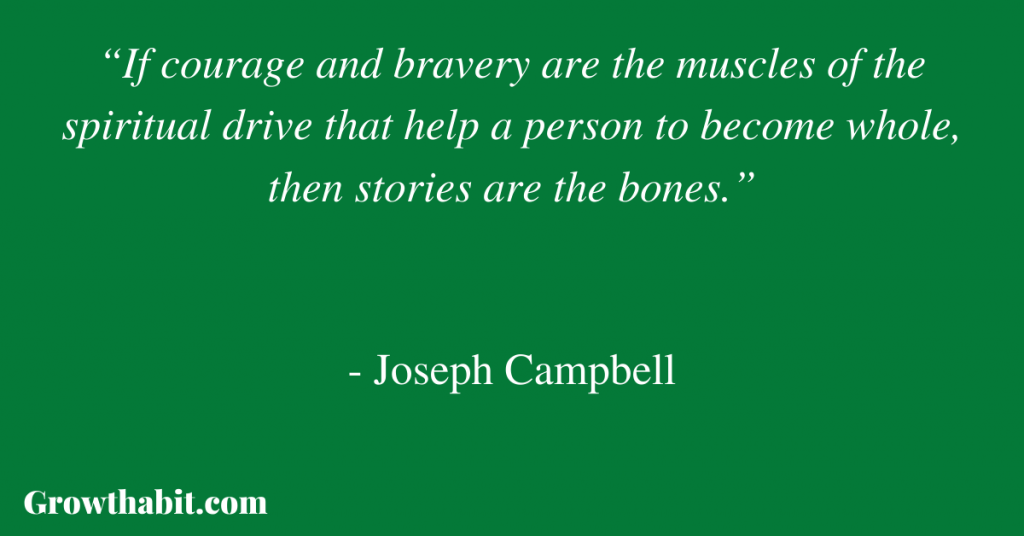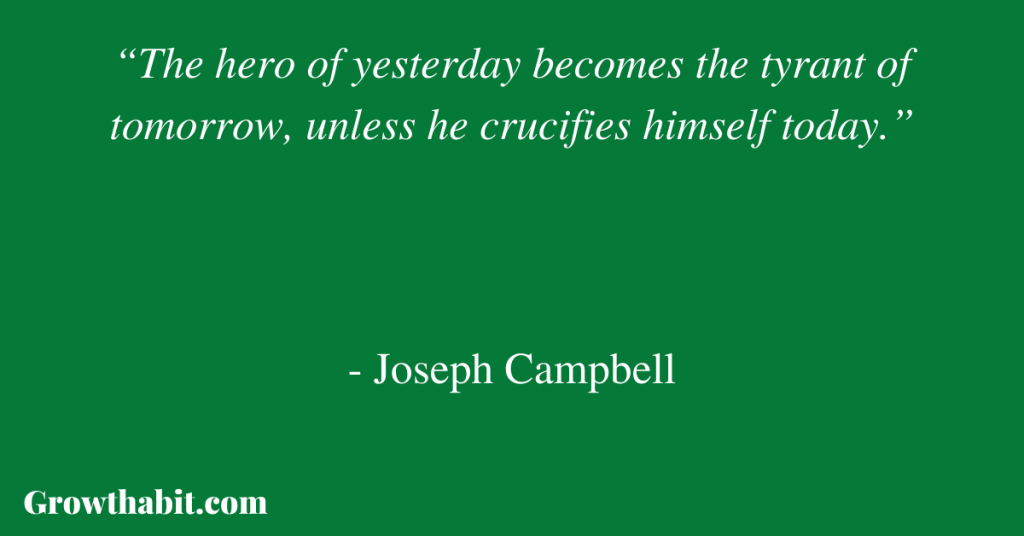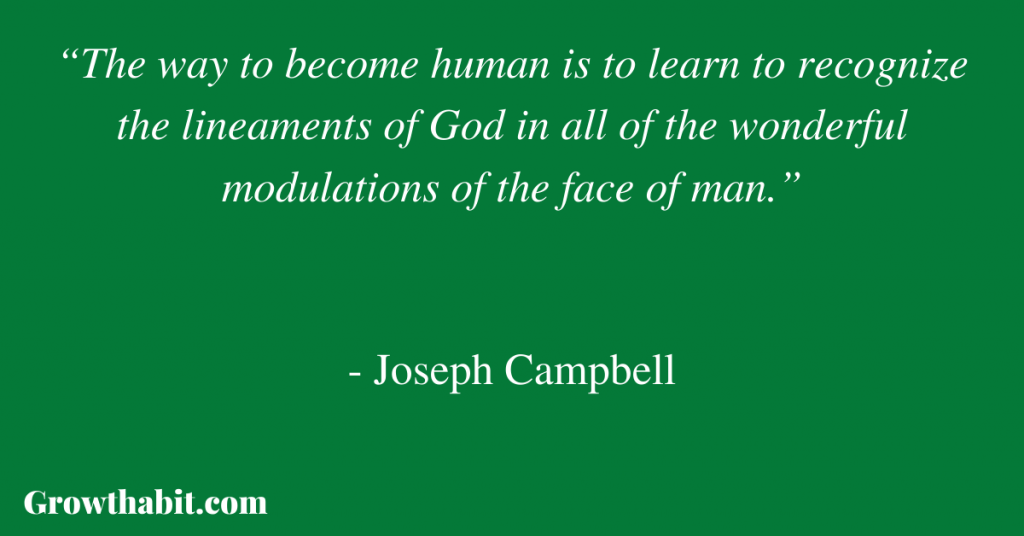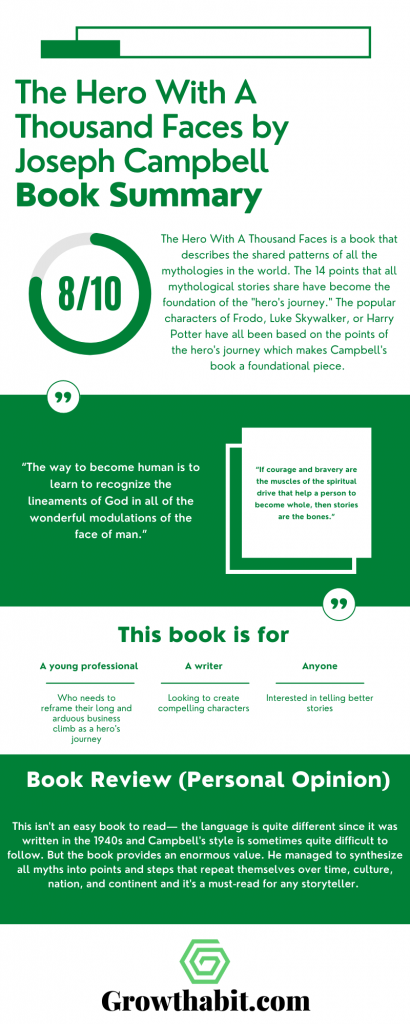The Hero With A Thousand Faces is a book that describes the shared patterns of all the mythologies in the world. The 14 points that all mythological stories share have become the foundation of the “hero’s journey.” The popular characters of Frodo, Luke Skywalker, or Harry Potter have all been based on the points of the hero’s journey which makes Campbell’s book a foundational piece.
Book Title: The Hero With A Thousand Faces
Author: Joseph Campbell
Date of Reading: March, 2018
Rating: 8/10
What Is Being Said In Detail:
The Hero With A Thousand Faces is divided into two major parts—The Adventure Of The Hero and The Cosmogonic Cycle. Each part has four chapters each.
Part ONE- The Adventure Of The Hero
- Chapter 1: Departure. This part covers the call to adventure and some next steps in the process—refusal of the call, a mentor figure or a supernatural aid, crossing the first threshold, and finding yourself “in the belly of the whale.”
- Chapter 2: Initiation. This part covers the dangerous path of trials, meeting with a supernatural being (goddess), the role of woman as a temptress, and finding peace and atonement with the father. The ending explains finding the perfect form or the high-point of the journey.
- Chapter 3: Return. This part covers the problem of not wanting to return back home, the magical flight and losing a part of the elixir, as well as rescue from without the journey all the way to the crossing of the threshold back. The hero who goes over this journey becomes the master of both worlds—the adventure and the ordinary world and gains the freedom to live his life.
- Chapter 4: The Keys. The Keys summarize the journey by enlisting all the steps in the process.
Part TWO- The Cosmogonic Cycle
- Chapter 1: Emanations. Emanate means to descend from God and this chapter follows the metaphysical creation of stories and myths through the folk stories of creation.
- Chapter 2: The Virgin Birth. This chapter explains the universe as a mother (or chaos and descent) and the womb of redemption (birth as an opportunity for redemption). Also, this part shows the folk stories of virgin motherhood.
- Chapter 3: Transformations of the Hero. This chapter shows the multiple roles a hero can take in his transformation: lover, warrior, emperor & tyrant, world redeemer, and saint.
- Chapter 4: Dissolutions. This chapter talks about the end of the microcosm (end of the hero’s life) and the end of the macrocosm (the end of creation).
Most Important Keywords, Sentences, Quotes:
PREFACE
“As we are told in the Vedas: “Truth is one, the sages speak of it by many names.”
“When the ruler was ethical and whole, the culture was also.”
“monomyth, a word he identifies as one coined by James Joyce, he puts forth the ancient idea—that the mysterious energy for inspirations, revelations, and actions in heroic stories worldwide is also universally found in human beings.”
“There is a “great price” to be paid to live in such an attitude of wholeness, for it means one must abandon the old unconscious way of life, including, for the fool, some of one’s former self-indulgent foolishnesses.”
“They maintain that they will try anything and look anywhere for the treasure, as long as the ways and means to do so avoid all difficulty, yet also satisfy their every appetite. In seeking to avoid all peril, discomfort, and “all love that might ever cause us heartache, they thus find and bring to themselves only the empty assets of self-delusion and an aversion to real life.”
“The definitive guidance is this: Whosoever desires to explore The Way — Let them set out—for what more is there to say?”
“If courage and bravery are the muscles of the spiritual drive that help a person to become whole, then stories are the bones.”
“No matter how much “much” a person might otherwise possess, they were seen as poor—and worse, as imperiled—if they did not know stories they could turn to for advice, throughout and till the very end of life.”
“It appears that “culture at edge of utter corruption” and “world at the edge of utter destruction” are two of the oldest themes to be found in stories of the human race.”
“If the world has a soul, then story informs and heals and spiritually grows the cultures, and the peoples within those cultures, through its universal cache of idioms and images. In ancient Hebraic, this concept is known as tikkun olam; meaning repair of the world soul.”
”Nothing contributes so much to tranquilizing the mind as a steady purpose—a point on which the soul may fix its intellectual eye.”
“to come from out of nowhere, more often too, in mythos, the answers come only from a hard labor that is kept to day after day.”
“At the end of a life that has meaning, the point is not that one is perfected, but that one will still carry a view of self and the world that is divine—and not just some kind of lazy drift.”
“Compelling experiences add to the development of the hero and heroine.”
“Recall that an archetype is a representation of the Irrepresentable.”
“Once could say it is a phenomenon precisely related to the idea of the monomyth that Campbell defines; something larger than life infuses the human—if they can break themselves open and accept it.”
“He points to their special interest in the plausible call that rises within human beings —the call that causes individuals who have been living highly externalized lives to stop, take notice, and redirect themselves to a higher self—or else suffer becoming more and more lackluster and world weary.”
“They remember that they are remembering. They tell what has been since the beginning of time. As Campbell has put it many times: the Mythic is the one deed done by many, many people.”
“This is the main point, it seems to me, for anyone who has the calling of healer, storyteller, poet, artist, leader—as Walt Whitman counseled, “to embrace all our contradictions”
”. . . [One] is a physical deed, as in saving the life of another. But the second kind is spiritual. It is the one who has learned or found something in the supernormal range of human spiritual life, and then came back and communicated it.”
PROLOGUE The Monomyth
“The so-called rites of passage, which occupy such a prominent place in the life of a primitive society (ceremonials of birth, naming, puberty, marriage, burial, etc.),”
“severance, whereby the mind is radically cut away from the attitudes, attachments, and life patterns of the stage being left behind.”
“But in the dream the forms are quirked by the peculiar troubles of the dreamer, whereas in myth the problems and solutions shown are directly valid for all mankind.”
“The hero, therefore, is the man or woman who has been able to battle past his personal and local historical limitations to the generally valid, normally human forms.”
“The hero has died as a modern man; but as eternal man—perfected unspecific, universal man—he has been reborn. His second solemn task and deed therefore (as Toynbee declares and as all the mythologies of mankind indicate) is to return then to us, transfigured, and teach the lesson he has learned of life renewed.”
“Perhaps some of us have to go through dark and devious ways before we can find the river of peace or the highroad to the soul’s destination.”
“A hero ventures forth from the world of common day into a region of supernatural wonder: fabulous forces are there encountered and a decisive victory is won: the hero comes back from this mysterious adventure with the power to bestow boons on his fellow man.”
“separation or departure, will be shown in Part I, Chapter I, in five subsections: (1) “The Call to Adventure,” or the signs of the vocation of the hero; (2) “Refusal of the Call,” or the folly of the flight from the god; (3) “Supernatural Aid,” the unsuspected assistance that comes to one who has undertaken his proper adventure; (4) “The Crossing of the first Threshold”; and (5) “The Belly of the Whale,” or the passage into the realm of night. The stage of the trials and victories of initiation will appear in Chapter II in six subsections: (1) “The Road of Trials,” or the dangerous aspect of the gods; (2) “The Meeting with the Goddess” (Magna Mater), or the bliss of infancy regained; (3) “Woman as the Temptress,” the realization and agony of Oedipus; (4) “Atonement with the Father”; (5) “Apotheosis”; and (6) “The Ultimate Boon.”
“Frequently he is honored by his society, frequently unrecognized or disdained. He and/or the world in which he finds himself suffers from a symbolical deficiency.”
”To God all things are fair and good and right,” declares Heraclitus; “but men hold some things wrong and some right.”
PART ONE The Adventure of the Hero
“This first stage of the mythological journey—which we have designated the “call to adventure” —signifies that destiny has summoned the hero and transferred his spiritual center of gravity from within the pale of his society to a zone unknown.”
“dull case of the call unanswered; for it is always possible to turn the ear to other interests.”
“Walled in boredom, hard work, or “culture,” the subject loses the power of significant affirmative action and becomes a victim to be saved.”
“Not all who hesitate are lost. The psyche has many secrets in reserve. And these are not disclosed unless required.”
“Willed introversion, in fact, is one of the classic implements of creative genius and can be employed as a deliberate device.”
“For those who have not refused the call, the first encounter of the hero-journey is with a protective figure (often a little old crone or old man) who provides the adventurer with amulets against the dragon forces he is about to pass.”
“Atonement (at-one-ment) consists in no more than the abandonment of that self-generated double monster—the dragon thought to be God (superego) and the dragon thought to be Sin (repressed id).”
“And in Australia, about a year following the ordeal of the circumcision, the candidate for full manhood undergoes a second ritual operation-that of subincision (a slitting open of the underside of the penis, to form a permanent cleft into the urethra). The opening is termed the “penis womb.” It is a symbolical male vagina. The hero has become, by virtue of the ceremonial, more than man.”
“Precisely the same bell is rung in the Christian Mass at the moment when God, through the power of the words of the consecration, descends into the bread and wine. And the Christian reading of the meaning also is the same: Et Verbum caro factum lM est, i.e., “The Jewel is in the Lotus”: Om mani padme hum.”
”The heavenly is like Tao. Tao is the Eternal. The decay of the body is not to be feared.” The Japanese have a proverb: “The gods only laugh when men pray to them for wealth.”
“WHEN the hero-quest has been accomplished, through penetration to the source, or through the grace of some male or female, human or animal, personification, the adventurer still must return with his life-transmuting trophy.”

“But the responsibility has been frequently refused. Even the Buddha, after his triumph, doubted whether the message of realization could be communicated, and saints are reported to have passed away while in the supernal ecstasy. Numerous indeed are the heroes fabled to have taken up residence forever in the blessed isle of the unaging Goddess of Immortal Being.”
“Muchukunda, in other words, instead of returning, decided to retreat one degree still further from the world. And who shall say that his decision was altogether without reason?”
“The hero adventures out of the land we know into darkness; there he accomplishes his adventure, or again is simply lost to us, imprisoned, or in danger; and his return is described as a coming back out of that yonder zone.”
“How communicate to people who insist on the exclusive evidence of their senses the message of the all-generating void?”
“Rip van Winkle is an example of the delicate case of the returning hero. Rip moved into the adventurous realm unconsciously, as we all do every night when we go to sleep. In deep sleep, declare the Hindus, the self is unified and blissful; IS therefore deep sleep is called the cognitional state. But though we are refreshed and sustained by these nightly visits to the source-darkness, our lives are not reformed by them; we return, like Rip, with nothing to show for the experience but our whiskers.”
“He had descended consciously (awake) into the kingdom of the unconscious (deep sleep) and had incorporated the values of the subliminal experience into his waking personality.”
”Lust was sore upon her, for that the desire of women is fiercer than the desire of men, and she was ashamed of her own shamelessness.”
“No matter how attractive or impressive they may seem, they remain but convenient means, accommodated to the understanding. Hence the personality or personalities of God—whether represented in trinitarian, dualistic, or Unitarian terms, in polytheistic, monotheistic, or henotheistic terms, pictorially or verbally, as documented fact or as apocalyptic vision—no one should attempt to read or interpret as the final thing”
“The individual, through prolonged psychological disciplines, gives up completely all attachment to his personal limitations, idiosyncrasies, hopes and fears, no longer resists the self-annihilation that is prerequisite to rebirth in the realization of truth, and so becomes ripe, at last, for the great at-one-ment.”
“for when a civilization has passed from a mythological to a secular point of view, the older images are no longer felt or quite approved.”
PART Two The Cosmogonic Cycle
“But if we are to grasp the full value of the materials, we must note that myths are not exactly comparable to dream. Their figures originate from the same sources—the unconscious wells of fantasy—and their grammar is the same, but they are not the spontaneous products of sleep.”
“all things and beings — are the effects of a ubiquitous power out of which they rise, which supports and fills them during the period of their manifestation, and back into which they must ultimately dissolve. This is the power known to science as energy, to the Melanesians as mana, to the Sioux Indians as ivakonda, the Hindus as sliakti, and the Christians as the power of God.”
“The key to the modern systems of psychological interpretation therefore is this: the metaphysical realm = the unconscious. Correspondingly, the key to open the door the other way is the same equation in reverse: the unconscious = the metaphysical realm.”
“This is the great theme and formula of the cosmogonic cycle, the mythical image of the world’s coming to manifestation and subsequent return into the nonmanifest condition.”
“According to the Stoic doctrine of the cyclic conflagration, all souls are resolved into the world soul or primal fire.”
“Herein lies the basic paradox of myth: the paradox of the dual focus. Just as at the opening of the cosmogonic cycle it was possible to say “God is not involved, but at the same time “God is creator-preserver-destroyer,” so now at this critical juncture, where the One breaks into the many, destiny “happens, but at the same time “is brought about.”
“The Chinese chronicles record that when the earth had solidified and the peoples were settling in the riverlands, Fu Hsi, the “Heavenly Emperor” (2953-2838 B.C.), governed among them. He taught his tribes how to fish with nets, to hunt and to rear domestic animals, divided the people into clans, and instituted matrimony. From a supernatural tablet entrusted to him by a horse-shaped scaly monster out of the waters of the river Meng, he deduced the Eight Diagrams, which remain to this day the fundamental symbols of traditional Chinese thought.”

“In sum: the child of destiny has to face a long period of obscurity. This is a time of extreme danger, impediment, or disgrace. He is thrown inward to his own depths or outward to the unknown; either way, what he touches is a darkness unexplored.”
“Just as in the history of the universe, so also in that of nations: emanation leads to dissolution, youth to age, birth to death, form-creative vitality to the dead weight of inertia.”
“Life surges, precipitating forms, and then ebbs, leaving jetsam behind. The golden age, the reign of the world emperor, alternates, in the pulse of every moment of life, with the waste land, the reign of the tyrant. The god who is the creator becomes the destroyer in the end.”
“The hero of yesterday becomes the tyrant of tomorrow, unless he crucifies himself today.”
“Thomas Aquinas, as the result of a mystical experience while celebrating mass in Naples, put his pen and ink on the shelf and left the last chapters of his Summa Theologica to be completed by another hand. “My writing days,” he stated, “are over; for such things have been revealed to me that all I have written and taught seems of but small account to me, wherefore I hope in my God, that, even as the end has come to my teaching, so it may soon come in my life.” Shortly thereafter, in his forty-ninth year, he died.”
EPILOGUE Myth and Society
“Mythology has been interpreted by the modern intellect as a primitive, fumbling effort to explain the world of nature (Frazer); as a production of poetical fantasy from prehistoric times, misunderstood by succeeding ages (Muller); as an instruction, to shape the individual to his group (Durkheim);”
“Mythology is all of these.”
“From the standpoint of the way of duty, anyone in exile from the community is a nothing. From the other point of view, however, this exile is the first step of the quest.”
“The aim is not to see, but to realize that one is, that essence; then one is free to wander as that essence in the world.”
“Hence separateness, withdrawal, is no longer necessary. Wherever the hero may wander, whatever he may do, he is ever in the presence of his own essence—for he has the perfected eye to see. There is no separateness. Thus, just as the way of social participation may lead in the end to a realization of the All in the individual, so that of exile brings the hero to the Self in all.”
“The way to become human is to learn to recognize the lineaments of God in all of the wonderful modulations of the face of man.”

“An unconscious identification took place, and this was finally rendered conscious in the half-human, half-animal, figures of the mythological totem-ancestors. The animals became the tutors of humanity. Through acts of literal imitation—such as today appear only on the children’s playground (or in the madhouse) —an effective annihilation of the human ego was accomplished and society achieved a cohesive organization.”
”Live, “Nietzsche says, “as though the day were here. ” It is not society that is to guide and save the creative hero, but precisely the reverse. And so every one of us shares the supreme ordeal —carries the cross of the redeemer—not in the bright moment s of his tribe’ s great victories, but in the silences of his personal despair .”
Book Review (Personal Opinion):
This isn’t an easy book to read— the language is quite different since it was written in the 1940s and Campbell’s style is sometimes quite difficult to follow. But the book provides an enormous value. He managed to synthesize all myths into points and steps that repeat themselves over time, culture, nation, and continent and it’s a must-read for any storyteller.
Rating: 8/10
This Book Is For (Recommend):
- Anyone interested in telling better stories
- A writer looking to create compelling characters
- A young professional who needs to reframe their long and arduous business climb as a hero’s journey
If You Want To Learn More
Here’s a nice video that graphically depicts the hero’s journey.
SuperCut
How I’ve Implemented The Ideas From The Book
I’ve spent years as a public speaker doing workshops where I created experiences for the people attending so they can feel like they’re on a hero’s journey.
One Small Actionable Step You Can Do
Whatever you’re facing now (or refuse to face now), remember that’s a part of the hero’s journey. Answer the call, face the challenges, and you will overcome them by transforming yourself into a better person. Answer the call!

